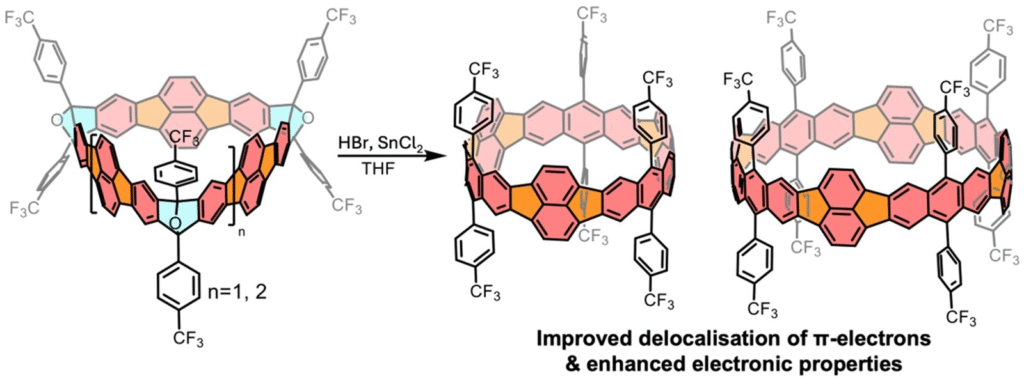Chemists at the National University of Singapore have broken new ground with the synthesis of fully π-conjugated carbon nanobelts. These novel structures offer unprecedented electronic properties and promise to revolutionize organic semiconductors and quantum materials. Delve into the synthetic breakthroughs and implications for future technologies.
Breakthrough in Carbon Nanobelt Synthesis
The groundbreaking work of the NUS team in synthesizing fully π-conjugated carbon nanobelts (CNBs) represents a significant stride in the field of materials chemistry. Traditionally, the synthesis of these CNBs posed formidable challenges due to the inherent difficulty in creating fully conjugated and stable structures. The team employed a sophisticated synthetic strategy that combined advanced molecular design with meticulous chemical processes, setting a new precedent in the field.

*Credit: Nature Synthesis (2025). DOI: 10.1038/s44160-025-00797-5*
At the heart of their strategy lay the use of carefully chosen molecular building blocks. These precursors were specifically selected to promote the formation of fully conjugated systems. The synthesis began with the design of a series of aromatic precursors, which were then subjected to intricate chemical reactions. Employing cyclodehydrogenation, a key process, they successfully forged the annulene rings of the nanobelts. This method involved the strategic use of oxidative conditions to remove hydrogen atoms from the molecules, thereby closing the aromatic gap and ensuring effective π-conjugation across the nanobelt.
A particularly innovative aspect of their approach was the integration of non-alternant carbon frameworks into the CNBs. Unlike traditional alternant hydrocarbons, which consist of an even distribution of carbon double and single bonds, non-alternant carbon structures contain an irregular pattern of bonding. This unique characteristic introduces curvature and twist in the molecular framework, which enhances electron delocalization, thereby augmenting the electrical properties of the material. Electron delocalization is a crucial feature for materials intended for electronic applications, as it facilitates the efficient movement of charge carriers through the material.
While non-alternant frameworks present considerable advantages, incorporating them successfully into CNBs was not without challenges. One of the major obstacles was maintaining the stability of these molecular frameworks during synthesis. Such frameworks have a tendency to undergo spontaneous reactions that can lead to undesired side products. The NUS team overcame this by carefully optimizing reaction conditions, incorporating mild reaction temperatures and specific catalysts that favor the formation of the desired π-conjugated structures. This meticulous approach enabled the team to retain the integrity of the nanobelt framework, ultimately leading to stable and highly conjugated CNBs.
Another challenge involved controlling the molecular weight and uniformity of the resulting CNBs. Variability in these parameters can significantly affect the physical properties of the nanobelt, impacting their suitability for electronic applications. To address this, the team employed a modular approach to synthesis, allowing for fine-tuning of molecular dimensions by varying the lengths and types of building blocks used. This customization capability ensured the production of CNBs with uniform and consistent properties, tailored for specific applications.
The significance of these innovations cannot be overstated. The ability to synthesize fully π-conjugated CNBs with non-alternant carbon frameworks opens new avenues for developing advanced electronic materials. These CNBs exhibit enhanced electron mobility and unique optoelectronic properties, setting the stage for their potential use in next-generation electronic devices. Furthermore, the application of these advanced synthetic strategies is not limited to CNBs alone. They hold promise for the development of other π-conjugated materials, potentially revolutionizing the materials used in organic electronics and optoelectronics.
The groundwork laid by the NUS team has substantially shifted the paradigm in the synthesis of CNBs, overcoming longstanding challenges that hindered their development for practical applications. The intricacy of the molecular design and the precision of the chemical processes employed highlight an exemplary path forward for researchers in the field. As a result of these advances, the stage is set for the application of CNBs in areas beyond basic research, encompassing a broad spectrum of technological innovations.
The next chapter will explore the unique electronic properties of these newly developed CNBs. By focusing on electronic innovations arising from the incorporation of non-alternant frameworks, the remarkable potential of CNBs in electronic technologies will be further unveiled.
To delve deeper into the science behind these remarkable structural forms, one can examine the inspired creations that adhere to the principles of complex theoretical frameworks, much like those governing the synthesis of CNBs.
Unique Electronic Properties of CNBs
The unique electronic properties of fully π-conjugated carbon nanobelts (CNBs) mark a significant leap in nanomaterial science. The innovations that arise from these novel structures have been keeping researchers and technology enthusiasts intrigued. One of the intriguing aspects of CNBs lies in their structural integration of five-membered cyclopentadienyl units. This integration plays a pivotal role in adding electronic flexibility, a factor paramount to the performance in various electronic applications.
The cyclopentadienyl units introduce a configuration that contrasts with traditional hexagonal carbon-ring-based nanostructures. This configuration deviates from the standard aromatic sextet structure, which traditionally confines the electron flow path along predictable routes. The promise here comes from the freedom that the five-membered ring introduces, which is typically referred to as non-alternant carbon framework. The presence of such frameworks facilitates novel electron delocalization patterns. This ultimately results in enhanced electronic conductivity and versatility, crucial for modern electronic applications.
One cannot overstate the role of non-alternant units in ushering in a new era of material behavior. By embedding these non-alternant structures within the CNBs, the electronic characteristics transform dramatically. The non-standard arrangement allows for lower resistance paths and enhanced π-electron overlap, elevating electronic performance. This innovative structuring leads to an exemplar phenomenon: the emission of bright red light from CNBs. The intrinsic flexibility offered by cyclopentadienyl units, combined with non-alternant embedding, creates unique photophysical conditions. These conditions enable a wide array of optoelectronic behaviors not possible with conventional materials.
The bright red light emission is a direct outcome of these novel electronic configurations. Such properties not only broaden the utility of CNBs in optoelectronics but also enhance their functionality in creating organic light-emitting diodes (OLEDs). OLEDs have been progressively replacing traditional lighting technologies, offering advantages in terms of efficiency and design flexibility. The CNB’s potential in OLEDs opens new avenues for more efficient, vibrant display technologies that can lead to thinner, more flexible screens. This enhancement translates directly to consumer electronics, making devices lighter and more energy-efficient.
Furthermore, the electronic innovations conferred by CNBs hold great potential for solar cell technologies. Solar cells rely heavily on materials that harness light and convert it into electricity efficiently. The superior electronic conductivity and flexibility of CNBs can revolutionize the design and efficiency of photovoltaic modules. The extraordinary electronic properties can boost light absorption efficiency and charge carrier mobility. Such improvements could lead to significant gains in electricity generation efficiency, which is critical for the future of sustainable energy solutions.
By advancing the CNBs, a shift towards more durable, higher-output solar cells is conceivable. These materials allow for lighter installations and diverse applications beyond traditional solar panel setups. Solar power technology, integrated with CNBs, can extend its reach into mobile devices, wearables, and even textiles. This innovation revolution could mean a dramatic shift in how society harvests and utilizes renewable energy.
The stride towards these technological breakthroughs is not without challenges. However, it is intrinsic innovations like those offered by cyclopentadienyl embedding and π-conjugation that provide the key to overcoming traditional material limitations. With CNBs spearheading these advancements, the scope for their application widens exponentially. Innovations in material science such as this highlight the ongoing transition in how we envision future electronic devices and their impact on various industries.
As we explore these technological frontiers, it is imperative to consider the broader implications of CNBs beyond immediate applications. These new materials support the development of quantum materials, paving pathways to unravel correlated electron behaviors—a topic of significant interest in advancing organic semiconductors. These potentials provoke a rethink of semiconductor design, moving from a silicon-dominated field to a diverse, material-rich discipline.
Integrating fully π-conjugated CNBs into our technological fabric holds promise not just for new device capabilities, but for profound environmental and societal benefits as well. Their low-energy requirements for operation and their potential in creating sustainable electronic components push the boundaries of current technologies. The impact on reducing energy consumption and enhancing device functionality aligns with the growing need for sustainable advancements across industries.
Given the wide-ranging implications of these discoveries, it is crucial for researchers, developers, and industry professionals to pursue continuous exploration of CNBs. These advances present ample opportunity for collaboration and innovation that addresses some of the pressing technological challenges. As the horizon of CNB applications expands, the conversation should continue about their role in shaping a more efficient, sustainable future in technology. For further reading on the potential of groundbreaking materials in technology, one might explore relevant topics such as graphene’s advantages over traditional materials.
Future Applications and Implications in Technology
Fully π-conjugated carbon nanobelts (CNBs) are at the forefront of material science innovation. Their unique electronic properties, as discussed in the previous chapter, provide a foundation for imagining their transformative potential. Fully π-conjugated CNBs are more than just a novelty; they stand to become integral to a host of technological applications, especially in the realm of quantum materials. Such advances are opening new vistas, both by enabling novel functionalities and by offering unprecedented control over electronic behaviors.
One of the most promising applications lies in the development of quantum materials. The dense and continuous π-conjugated system of CNBs creates unique opportunities for manipulating quantum states. As researchers explore these capabilities, they find that CNBs can serve as reliable platforms for studying quantum coherence, decoherence, and entanglement. Such properties are fundamental to the burgeoning field of quantum computing. In this arena, CNBs might offer pathways to address some of the current limitations in qubit design, potentially leading to improved computational efficiency and stability. The ability to maintain coherence and reduce error rates in quantum systems could make these CNBs key components in the quest for practical quantum computers.
Moving beyond these immediate applications, CNBs may also influence the study of correlated electron behavior in carbon-based systems. Their design allows for significant interaction between electrons across the π-conjugated network. Such interactions are critical for understanding complex electron behaviors, including exotic phenomena like superconductivity and the fractional quantum Hall effect. By crafting CNBs with specific structural parameters, scientists can fine-tune these electron correlations, conducting experiments that provide insights into the fundamental workings of advanced materials.
The implications of fully π-conjugated CNBs extend further into the realm of organic semiconductors. Traditional materials often face challenges with stability, scalability, and performance at elevated temperatures. CNBs, due to their robust π-conjugation, exhibit increased stability and conductivity, making them ideal candidates for integration into organic electronic devices. Devices such as organic light-emitting diodes (OLEDs) and organic photovoltaics can benefit substantially. As reported in www.scienceteen.com/a-very-important-light-source-in-daily-life-is-ledlight-emitting-diode/, OLEDs are already a part of everyday technology. CNBs could upgrade these devices, offering brighter emission with improved energy efficiency. Similarly, for solar cell applications, the CNBs’ excellent transport properties could enhance light absorption and charge carrier mobility, resulting in higher energy conversion efficiencies.
In materials science, this discovery signifies a major stride forward. The availability of materials that combine flexibility with conductivity and stability opens new frontiers for innovation. As CNBs bridge the gap between organic and inorganic materials, they offer exciting possibilities for hybrid materials with bespoke properties. Tailored materials such as these could revolutionize how we design everything from flexible electronics to wear-resistant coatings.
Such developments create numerous opportunities for researchers across various fields. Chemists are invited to delve deeper into the synthesis and functionalization of CNBs, exploring how different substituent groups and structural modifications can further tailor their properties. Physicists can investigate the quantum phenomena associated with CNBs, contributing to theoretical models that explain their behavior. Electrical engineers have the chance to incorporate CNBs into circuit designs, developing new electronic devices that leverage their unique capabilities.
Fully π-conjugated CNBs present a fertile ground for interdisciplinary collaboration. Their exploration will require joint efforts from material scientists, quantum physicists, and engineers. As we stand on the brink of these discoveries, the potential is immense. The journey of uncovering the full spectrum of applications for CNBs has just begun, and the path ahead is as intriguing as it is promising. For those eager to explore further, www.examplewebsite.com offers a deeper dive into the ongoing research and emerging applications of these fascinating materials.
Final words
Fully π-conjugated carbon nanobelts represent a breakthrough in carbon nanostructures, featuring unique electronic properties and broader potential in future technologies. Their synthesis opens new directions in semiconductors and quantum materials, promising to refine the design and utilization of carbon-based systems. These advances serve as a foundation for further exploration and application in diverse fields.



